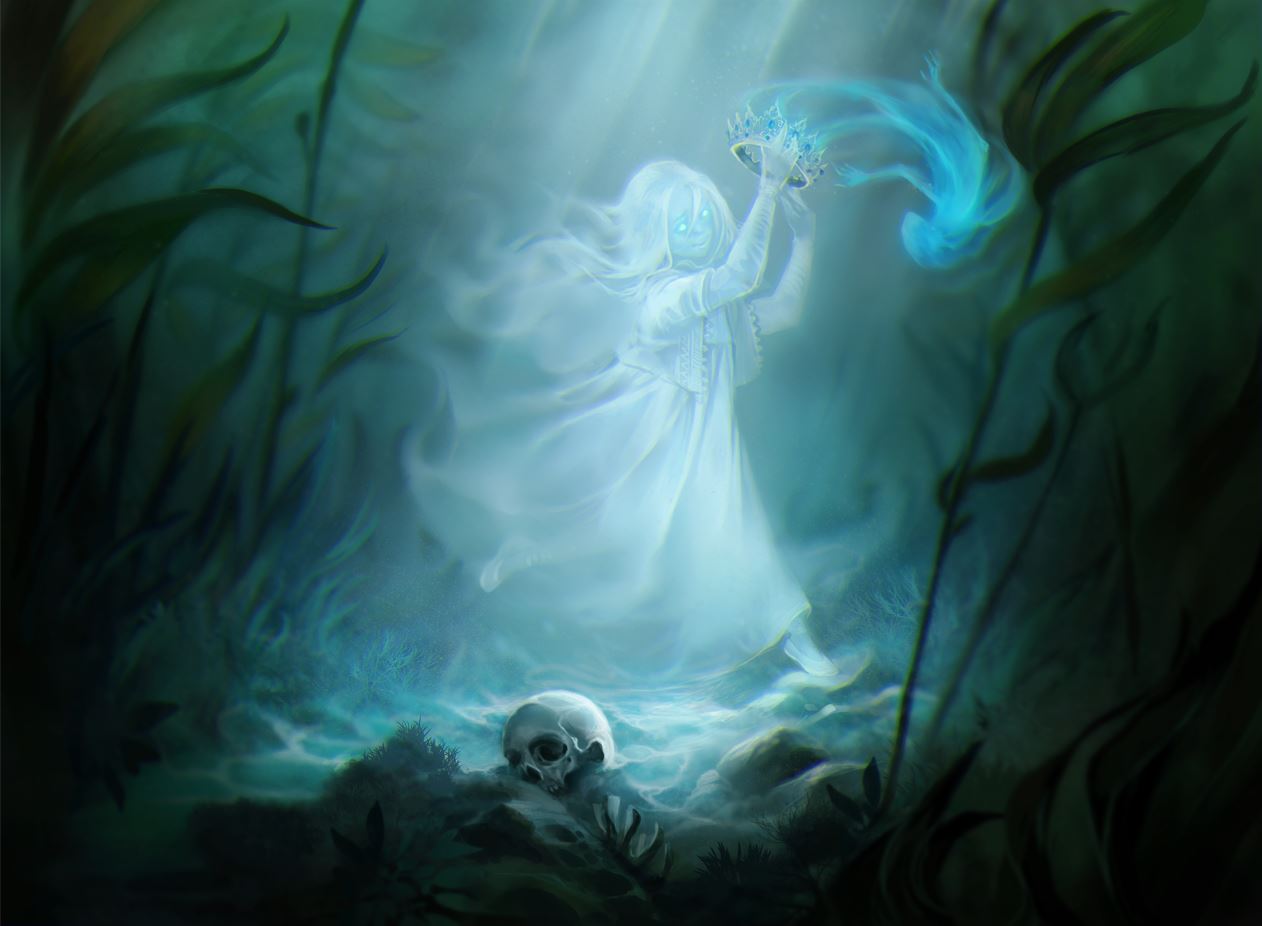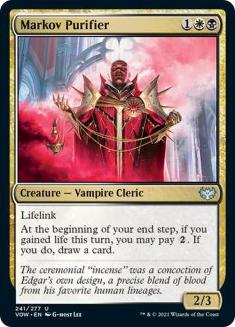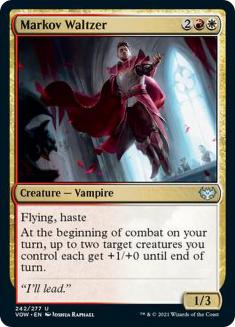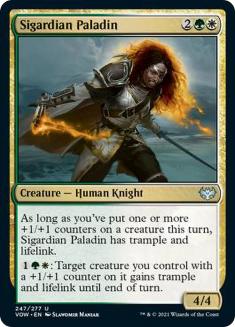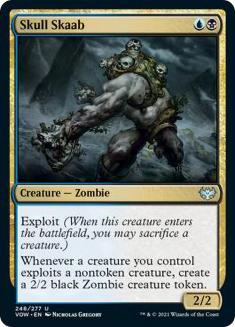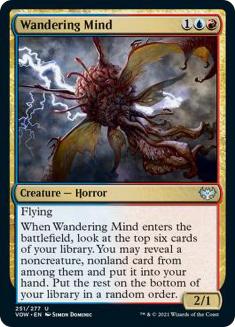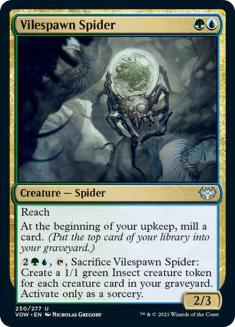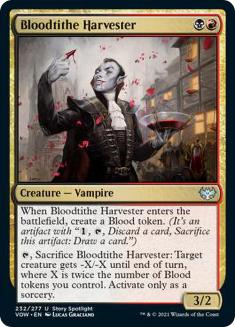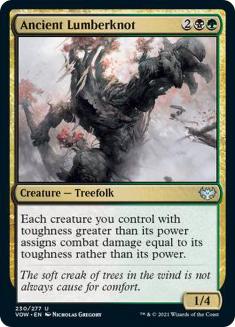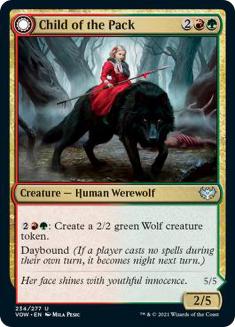When two sets aren’t being drafted together, I generally don’t find it very helpful to compare one to another. For example, if someone had asked how Adventures in the Forgotten Realms would differ from Strixhaven, I’d suggest that grounding themself in Strixhaven as a point of comparison is more likely to lead to carrying over baggage unnecessarily than simply starting fresh (unless Strixhaven was the only previous set they’d drafted). However, when it comes to this pair of Innistrad sets, I think the thematic and mechanical overlaps are strong enough that many players won’t be able to help drawing comparisons, so let’s dive into how they compare.
My top-level first impressions are that the commons in Innistrad: Crimson Vow look weaker; the removal’s more expensive and/or less versatile and there’s much less built-in card advantage. I think the fixing is a little weaker overall, particularly because almost all of it costs exactly three mana, which makes the curve harder to manage in decks that are trying to splash. Also, there are only ten uncommon gold cards instead of twenty, making fixing less structurally important.
On the other hand, Blood tokens offer cheap card filtering, which can make splashing much less painful, since you can just discard cards you can’t cast, or dig to find your missing colors, which should make splashing easier in decks that are less invested in it, which is to say that compared to Innistrad: Midnight Hunt, we can expect green and blue to splash less and red and black to splash more.
As for more precise comparisons, I’d like to consider each archetype separately.
Azorius
Both sets feature the disturb keyword, but making enchantments changes the context considerably. My expectation is that Azorius in Innistrad: Crimson Vow won’t grind as well. In Innistrad: Midnight Hunt, trading was good for the Azorius deck because the creatures that traded would come back as new creatures, which meant removal was weak against the deck. When the creatures come back as Auras, a removal spell will answer both the Aura and the creature you enchanted, and while that’s not exactly the same two-for-one that usually happens when an enchanted creature is killed because the disturb Aura didn’t “cost a card,” it’s likely a big tempo swing because you’re down all the mana you spent.
This isn’t to say that disturb is bad now, or even necessarily that it’s worse, but while it had previously lined up well against opposing removal, now it’s more likely to line up well against opposing creatures, as Auras let you build creatures that trump the opponent’s creatures.
There’s also less of a focus on self-milling, and because these cards are flying Spirits on the front side, there are a lot more flyers in this set. Again, flying is good against opposing creatures, and not good against opposing removal, further solidifying that shift. I expect Azorius to play more similarly to how it plays in other sets, and I think it’s going to largely play as a Skies deck that uses Auras well. I’d say the last set that I think it might feel similar to is Theros Beyond Death.
Orzhov
Orzhov mostly moves away from caring about creatures dying, though there is some synergy between exploit and disturb that it can take advantage of. Markov Purifier suggests that it now cares more about gaining life, but Courier Bat is the only real common payoff for trying to do that. Courier Bat could end up being an important card in the set, since it’s among the most tempo-positive ways to generate card advantage available, but that’s not enough to really drive every Orzhov deck, so I think they’re going to be fairly low-synergy overall, and different individual decks will choose different possible synergies to focus on.
Black’s removal spells aren’t as strong as they were in Innistrad: Midnight Hunt, but the cards actually might end up being better as removal looks to be better-positioned in the format, given the change to disturb and general decrease in the number of ways to grind out a removal-heavy deck. I expect Bleed Dry to be the most broadly desirable of the removal spells, followed by Gift of Fangs, and then I think most decks won’t be excited about Grisly Ritual.
Boros
I might just not get Boros, but it continues to look weak to me. Haste and effects that grant extra power play well with the training cards in white and that basically seems like the extent of the synergy between the colors here, so I expect to prioritize training as highly in Boros as I would in Selesnya. I don’t really think the red and white cards look much better than they did in Innistrad: Midnight Hunt, but it’s possible that other colors have come down to its level.
Selesnya
With training taking the place of coven, it’s no longer as important to go wide or prioritize cheap zero- and one-power creatures. Now you just want to make sure you keep getting bigger creatures so your training creatures can keep scaling. The reprinted Bramble Armor and Snarling Wolf both seem better with training; Snarling Wolf is the easiest way to put a counter on a two-mana training creature when you attack on Turn 3 and Bramble Armor makes it much easier to train, while casting it instead of a creature made it harder to get coven.
I can imagine two different approaches to this archetype. One uses Bramble Armor and Drogskol Armaments to pump creatures to keep training in an aggressive build, and the other is more controlling, using strong late-game commons like Heron-Blessed Geist, Nebelghast Beguiler, and Flourishing Hunter. That deck might also want to use Mulch and Moldgraf Millipede, and at that point is likely playing at least one additional color as well.
Dimir
Exploit comes in to really make players wish decayed Zombies were still around; where Dimir used to have an abundance of all-but-free fodder, now it has to actually work for it. Fortunately, there’s a lot of pretty good fodder available, but this makes the archetype play more similarly to how you might expect Orzhov to play on Innistrad.
There are a few more angles to explore here though, such as discard synergy with cards like Selhoff Entomber and Scattered Thoughts playing with Ragged Recluse and Edgar’s Awakening, as well as filling your graveyard for Cobbled Lancer or anything that returns creatures. Of course, Blood tokens are still the easiest way to use discard synergies.
All in all, Dimir looks relatively synergistic for the format, so I wouldn’t be surprised if it’s relatively powerful again, even if it should play very differently from how it played in Innistrad: Midnight Hunt.
Izzet
Izzet has expanded into caring about all noncreature spells. The cheap instant-speed removal offered by Flame-Blessed Bolt and Abrade should play well with Syncopate, Fear of Death, and Syphon Essence in blue. Cruel Witness and Scattered Thoughts offer enough late-game strength for commons that I think I’d rather play a controlling version of Izzet rather than an aggressive version of Izzet by default in this format, where I think the opposite was true in Innistrad: Midnight Hunt. Weary Prisoner feels like a good pick for a card that will overperform in that archetype, where it will be very easy to flip to night, and the 2/6 should block exceptionally well for a red creature.
Decks like this often have to worry about flooding out late, but Blood tokens should prevent that. My hope is that this is an archetype where I’ll get to win some games with double Witness the Future sometimes, since Thirst for Discovery and Scattered Thoughts seem so good.
Simic
Mulch seems like a key card for Simic in this set, which makes me think it’ll still be common to splash here. Moldgraf Millipede and Flourishing Hunter both seem like excellent late-game cards for this deck, which makes me think it might want to include some black for graveyard stuff or high-toughness creatures, but splashing red for cheap removal would also make a lot of sense.
Vilespawn Spider and Moldgraf Millipede both push you to maximize your creature density, so that’s something to keep in mind even though there are a lot of appealing spells that fill your graveyard, like Mulch and Scattered Thoughts, so balancing your creature count against your enablers should be a priority while drafting, which should be familiar to people who drafted Simic in original Innistrad.
Rakdos
There are lots of commons that make Blood tokens and very few that use them. Bloodcrazed Socialite seems like a pretty strong card in an aggressive Vampire deck, and bad enough when you’re trying to block that I don’t think it’ll be hard to get, which means you shouldn’t need to prioritize other four-mana creatures.
There are only six common Vampires in red and black, which is actually one fewer than there were in Innistrad: Midnight Hunt, but there are twice as many uncommons (eight versus four, not counting Sanguine Statuette), so you’ll see more Vampires, but it’s worth noting that because so much of it’s at uncommon, a draft might not support very many players looking for Vampire synergies.
All in all, I expect Rakdos to be a little stronger in Innistrad: Crimson Vow just because I expect removal to be more important.
Golgari
I expect Golgari to be a relatively low-synergy color pair, as it was in Innistrad: Midnight Hunt. Sometimes you’ll gain thirteen life by curving Unhallowed Phalanx into Flourishing Hunter, but most of the time you’ll just be playing slightly defensive creatures and removal spells with a plan to block against aggressive decks and attack against blue decks.
The other notable synergy here is just using black’s fodder creatures and exploit creatures to fill your graveyard for Moldgraf Millipede, but it’s not like you’re really hurting to find big creatures you can cast, so I don’t think that synergy is especially important.
It’ll be really hard to try to build an aggressive deck in this color pair, but I don’t really know why enough would try.
Gruul
I think Werewolves are less of a trap in this format than they were in Innistrad: Midnight Hunt. Hungry Ridgewolf and Sporeback Wolf offer a better aggressive Wolf base to the bottom of the curve. Packsong Pup, Runebound Wolf, and Wolfkin Outcast offer appreciable rewards to Gruul drafters that other players won’t use. In 81 Innistrad: Midnight Hunt drafts, I’ve never drafted straight Gruul, but with so many good two-mana creatures that are best in exactly this archetype, I expect it to be fairly strong in Innistrad: Crimson Vow.
This analysis focused on commons, with a little bit of attention to uncommons. I have a fear that this set will be particularly dominated by rares, as a lot of rares look very strong, and most of the commons don’t. When you combine that with the fact that Blood tokens make it easier for everyone to dig for their rares, you have a format that might be particularly likely to revolve around rares. This means that removal, card selection, and good aggressive cards are likely to be the most important commons, which favors decks like Gruul (for aggression), Rakdos (a little of all of those), and possibly Izzet (for card selection and removal).
If the format does end up revolving more around rares, that could have the advantage of leading to greater balance among archetypes, as players should just play the colors of their best cards rather than defaulting to always playing the pair with the strongest colors, which might be a positive change after the last few Draft formats where, especially early, a particular pair was exceptionally dominant.

